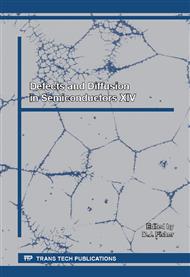[1]
M.Matsuoka, Non-Ohmic Properties of Zinc Oxide Ceramics, Japanese Journal of Applied Physics, 10(6) (1971) 736–46
Google Scholar
[2]
L.M. Levinson and H.R. Philipp, Zinc Oxide Varistors - A review, American Ceramic Society Bulletin, 65(4) (1986) 639-46
Google Scholar
[3]
M.S. Kossman and E.G. Pettsold, О ВОЗМОЖНОСТИ ИЗГОТОВЛЕНИЯ СИММЕТРИЧНЫХ ВАРИСТОРОВ ИЗ ОКИСИ ЦИНКА С ПРИМЕСЪЮ ОКИСИ ВИСМУТА, Uch. Zap. - Leningr. Gos. Pedagog. Inst. im. A. I. Gertsena, 207 (1961) 191-7
Google Scholar
[4]
M.Matsuoka, T.Masuyama and Y.Iida, Voltage Nonlinearity of Zinc Oxide Ceramics Doped with Alkali-Earth Metal Oxide, Japanese Journal of Applied Physics, 8 (1969) 1275-6
DOI: 10.1143/jjap.8.1275
Google Scholar
[5]
M.Trontelj, D.Kolar and V.Krasevec, Influence of Additives on Varistor Microstructure, in Advances in Ceramics, 7, ED. M. F.Yan and A.H. Heuer, Am. Ceram. Soc., Columbus, (1984) 91-106
Google Scholar
[6]
T.Miyoshi, K.Maeda, K.Takahashi and T.Yamazaki, Effects of Dopants on the Characteristics of ZnO Varistors, in Advances in Ceramics, 1, ED. L.M. Levinson and D.C. Hill, Am. Ceram. Soc., (1981). 309-15
Google Scholar
[7]
D.R. Clarke, Grain Boundary Segregation in a Commercial ZnO-Based Varistor, Journal of Applied Physics, 50 (1979) 6829-32
DOI: 10.1063/1.325881
Google Scholar
[8]
M.El-Hofy, Grain Boundary Defects Induced Switching in Zn- Bi- Mo Ceramic, Defect and Diffusion Forum, 251-252, (2006) 13-20
DOI: 10.4028/www.scientific.net/ddf.251-252.13
Google Scholar
[9]
M.El-Hofy, Non-Ohmic Behavior of Some ZnO Ceramic Defective Ions with Different Valences, Defect and Diffusion Forum, 293 (2009) 91-7
DOI: 10.4028/www.scientific.net/ddf.293.91
Google Scholar
[10]
J.Wong, Nature of Intergranular Phases in Non-Ohmic ZnO Ceramics Containing 0.5 mol% Bi2O3, Journal of the American Ceramic Society, 57 (1974) 357-9
DOI: 10.1111/j.1151-2916.1974.tb10922.x
Google Scholar
[11]
J.Wong, P.Rao and E.F. Koch, Nature of an Intergranular Thin Film Phase in a Highly Non-Ohmic Metal Oxide Varistor, Journal of Applied Physics, 46 (1975) 1827-30
DOI: 10.1063/1.321749
Google Scholar
[12]
K.Mukae and I.Nagasawa, Effect of Pr Oxide and Donor Concentration in the Grain Boundary Region of ZnO Varistors, in Advances in Ceramics, 1, Ed. L. M. Levinson and D.C. Hill, Am. Ceram. Soc., Columbus, (1981) 331-42
Google Scholar
[13]
K.Mukae, K.Tsuda and I.Nagasawa, Non-Ohmic Properties of ZnO-Rare Earth Metal Oxide-Co3O4 Ceramics, Japanese Journal of Applied Physics, 16(8) (1977) 1361-8
DOI: 10.1143/jjap.16.1361
Google Scholar
[14]
D.R. Clarke, Varistor Ceramics, Journal of the American Ceramic Society, 82(3) (1999) 485-501
Google Scholar
[15]
Hubbell Power Systems Inc.-Ohio Brass, Zinc-Oxide Arrester Design and Characteristics, EU 1044-HR-2004.
Google Scholar
[16]
A.Bayadi, N.Harid, K.Zehar and S.Belkhiat, Simulation of Metal Oxide Surge Arrester Dynamic Behavior under Fast Transients, the International Conference on Power Systems Transients-IPST 2003, New Orleans, USA.
Google Scholar
[17]
M.Kobayashi, M.Mizuno, T.Aizawa, M.Hayashi and K.Mitani, Development of Zinc-Oxide Nonlinear Resistors and their Applications to Gapless Surge Arresters, in Proceedings of IEEE PES Summer Meeting (Mexico City, 1977), (1977) 682-8
DOI: 10.1109/tpas.1978.354595
Google Scholar
[18]
E.C. Sakshaug, J.S. Kresge and S.A. Miske, Jr., A New Concept in Station Arrester Design, IEEE Transactions on Power Apparatus and Systems, Vol. PAS-96, (1977) 647-56
DOI: 10.1109/t-pas.1977.32376
Google Scholar
[19]
U.Braunsberger, ZnO-Arresters for Overvoltage Protection in Pulsed Power Circuits, European Electromagnetic Launch Society 12th Topical Meeting 10th to 12th September 2001.
Google Scholar
[20]
N.Greenwood and A.Earnshaw, Chemistry of the Elements (2nd ed.), Butterworth–Heinemann, (1997). ISBN 0080379419.
Google Scholar
[21]
B.C.H. Steele, electronic Ceramics, Elsevier Science Publishers Ltd, (1991).
Google Scholar


